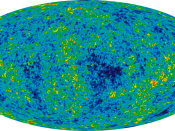Question 1
a) Infrared Astronomy
Infrared Astronomy is a study of the Infrared Radiations emitted from celestial objects. All objects from trees, buildings on the earth to distant galaxies emit infrared radiation. The cosmic dust particles block the view of the visible universe such as the center of the Milky Way but these cosmic dust particles are transparent in the Infrared Radiation wavelengths. It is very significant for studying asteroids, comets, planetary satellites and interstellar dust clouds where stars are forming. Also because of the expansion of the universe which shifts energy to longer wavelengths, most of the visible radiations emitted by stars and galaxies during early stages of the formation of the universe are now shifted to Infrared Radiation wavelength range.
b) Radio Waves
Radio waves have the longest wavelengths in the electromagnetic spectrum. Radio waves can be either very long or very short. Radio waves are extremely useful because they can go through the earth's atmosphere.
Radio waves are produced by charged particles moving back and forth.
Objects in space, such as planets and comets, giant clouds of gas and dust, and stars and galaxies, emit light at many different wavelengths. Some of the light they emit has very large wavelengths. These long waves are in the radio region of the electromagnetic spectrum. Radio telescopes gather and focus the radio waves from an object in space; the signal then returns to earth in full detail give astronomers valuable information about the planet or star. Radio astronomy has the advantage that sunlight, clouds, and rain do not affect observations.
Question 2
Due to the fact that 75% of the universe is filled with Hydrogen and 25% is Helium it is showing that there was a stage when the universe was the right density and temperature to create these since...


